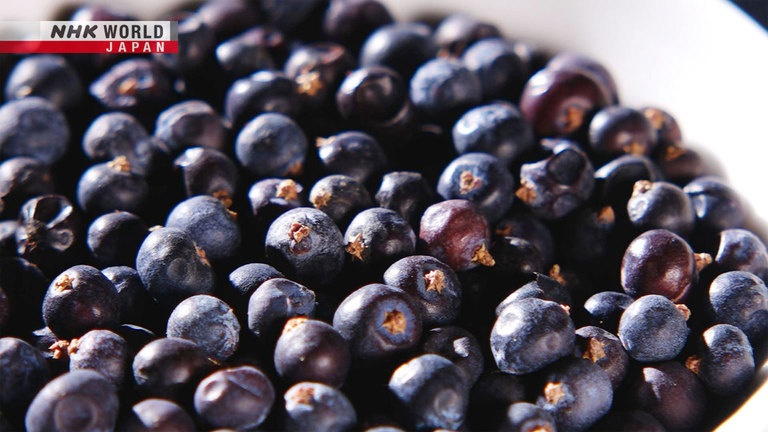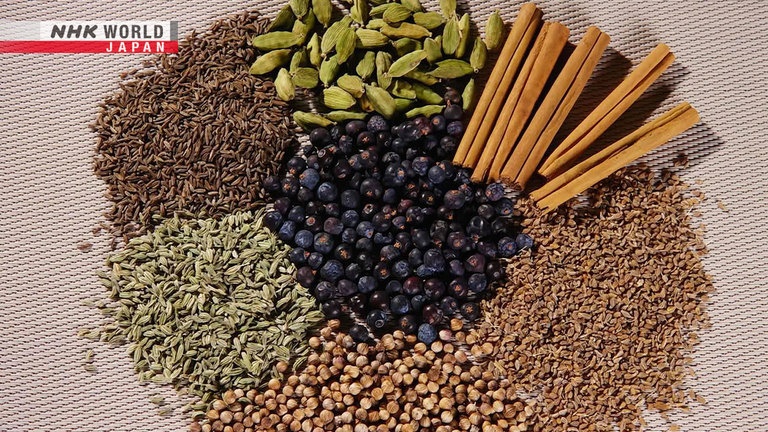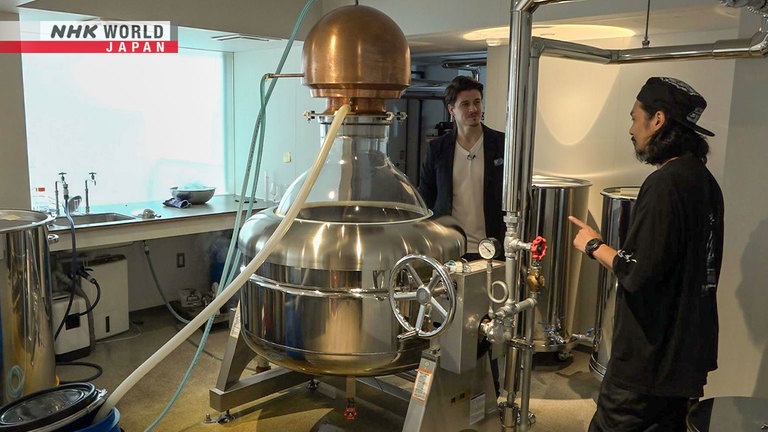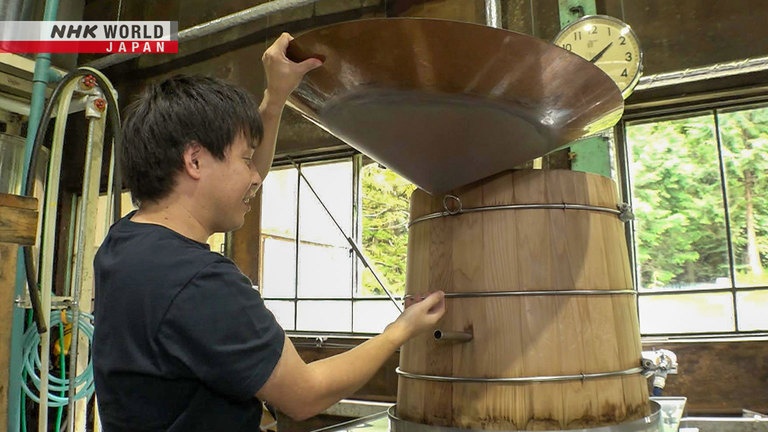JAPANESE GIN
Gin, the popular fragrant spirit made from juniper berries, is experiencing a global "craft" boom. Expert distilleries are popping up across Japan as well. In central Tokyo, taste botanical gin that pays homage to regional history. In Gifu Prefecture, quality water and lush seasonal crops make excellent gin. Also learn about a distillery that uses recycled cacao and beer products. This and more about Japan's cool gin scene. (Reporter: Kyle Card)




Transcript
Tokyo: this world-class metropolis is a veritable gourmet wonderland.
Discover the stories behind the ingredients that make this city so delicious - so "oishii."
Our focus today is gin, the clear spirit known for its aromatic qualities.
It's a popular base for cocktails.
Recently, a global "craft gin" boom has given way to a number of unique distilleries.
The movement is underway in Japan as well, and the country's novel gin is gaining traction worldwide.
Lovely aroma of juniper and coffee. This is lovely.
Distilleries are even popping up in central Tokyo.
Beyond Tokyo, a rich natural environment and distilling culture laid the foundation for some amazing Japanese gin.
It expands in my mouth. "Oishii."
Discover some new ways to enjoy gin!
With Japanese gin, the possibilities are endless.
Join us to find out more.
Trails to Oishii Tokyo.
Hello, everyone. My name is Kyle Card.
When you think of Japanese alcohol, sake often comes to mind.
But other varieties such as whiskey have gained worldwide acclaim,
and recently, the demand for Japanese gin has steadily increased.
In the midst of a worldwide gin boom, the demand for Japanese gin is steadily increasing.
So today we're going to explore the allure and intricacies of Japanese gin.
But to start off, how about a drink?
Kyle, a self-proclaimed gin novice, begins at a bar in Nakameguro, Tokyo.
They specialize in gin & tonics.
- Thanks for having me.
- Welcome.
Are these all gin?
Right. Craft gin from around the world.
That's a lot of gin.
We have many from Japan.
Over 30 types in this section.
He opened the bar to provide a causal space for people to explore the world of craft gin.
This is from the old capital, Kyoto.
Gin from Kyoto.
This is from the first distillery in Japan to specialize in gin, which was launched in 2016.
This pioneering Japanese craft gin has received international acclaim.
At this point, over half the production volume is consumed overseas.
Cheers.
A rich mix of aroma and spices.
Gin brings out the aromas of the spices,
herbs and fruits it's made with.
This also uses ingredients like
sansho pepper, yuzu citrus, and shiso leaves.
- You can make gin that way?
- Yes.
Gin with a Japanese touch.
The bar's all-you-can-drink course allows customers to sample various types.
But there's one rule:
You can't order the same one twice.
You have to keep exploring.
I see.
Next, he brings out a bottle from Niigata.
Wow.
Strong orange aroma and flavor.
This is from a company that originally
focused on health food products.
They use a lot of Japanese medicinal herbs and citrus.
They won a Japanese gin competition in 2023.
So this is the gin of the year? Cool.
Makes sense.
This is gin from the Goto Islands of Nagasaki.
What do you think the bottle design is trying to show?
What? It has meaning?
A type of plant or flower?
- You got it.
- Really?
The Goto Islands have a lot of Japanese camellias.
They use the seeds and other parts of the flower.
Very mild.
Just a lovely floral scent.
Experienced whiskey distillers started this gin distillery.
It was their way of giving themselves a new challenge.
- I see, so they know what they're doing.
- Right. Gin from experienced artisans.
What do you love about gin?
Gin is perfected by the human palate.
It's like how a chef chases that perfect flavor or sauce.
The more you drink it, the more you want to discover.
Very interesting.
Juniper berries are what makes gin, gin.
Any type of liquor can be used as a base.
Botanical herbs, spices and fruit peels can be added, to make an array of unique recipes.
The world's first gin was apparently made for medicinal use, by Italian monks in the 11th century.
During the Age of Discovery in the 17th century,
gin was seen as a cure for tropical diseases, and production spread in the Netherlands.
Then, William III of Holland introduced gin to England, when he ascended to the throne there.
After that, gin's popularity spread throughout England and around the world.
After becoming a common, mass-produced spirit, gin reached a turning point in 2009.
A small-scale craft distillery opened in London, and its use of traditional methods attracted a lot of attention.
This gave way to a craft gin boom, with more distilleries popping up around the world.
Awesome!
The boom hit Japan soon enough, where there are now over 100 unique gin distilleries.
Fukagawa, a historic area in eastern Tokyo, is lined with waterways, and a number of temples and shrines.
The area is recently popular for its many chic cafes.
In 2023, a new gin distillery was built there.
Is there really a distillery back here?
It's at the end of a small alleyway.
- Hello!
- Welcome.
Is this really a distillery?
Yes. We make alcohol here.
- It looks like a cozy bar.
- Yeah? Thank you.
That's the distillery back there?
Right. We designed and built it ourselves.
- You did all of that yourself?
- That's right.
- That's possible?
- Yes, it can be done.
Tell me more.
We made that to use in-house, and we make
a number of stills for experiments.
So you make a lot of glass ones?
That's mainly what we do, actually.
Sekiya is a third-generation maker of experimental tools.
He specializes in lab equipment for physics and chemistry experiments.
Wanting to expand their reach further, the company began developing essential oil stills for home use.
They were well-received by bartenders, which introduced Sekiya to the world of craft gin.
Wanting to distill his own gin, he used his experience and the company's resources
to build a still based on a design protype from Kyushu.
Looks heavy.
He's working on a gin product that'll hit the market soon.
He begins by pouring in a base sugar-cane spirit, that's around 60-proof.
Did the smell hit you at first?
Yeah. It's tough when you're hungover.
I bet.
A distiller by trade, Taki is also a painter.
Wanting to support Sekiya in his gin venture, he learned about distillation from scratch.
After adding water, botanicals are mixed in.
- What's this?
- Grounds from cold brew coffee.
Interesting!
It has some mint too.
There are many coffee roasters in this area.
It's a cool way of collaborating with the town.
He also adds juniper berries, the key ingredient for gin, and vetiver, which are grass roots used in perfumes.
These are peels of a type of sour citrus
from Kochi called bushukan.
What's happening?
It was frozen at -60℃ with its fibers
and aroma firmly intact.
That's released into the mix.
After that, the still is closed, and the distilling process begins.
Lovely aroma of juniper and coffee. This is lovely.
It's cool that we can see what's
happening through the glass.
Yeah, that's quite rare I think.
Alcohol and aroma vapors collect and cool on the metallic surface, and drip back down as condensation.
This increases the alcohol content to over 70-proof.
Adding water enhances flavor.
Those alcohol fumes, wow! Okay, that's strong. Wow!
- Very nice.
- Good aroma.
It really is.
This gin is their passion project.
Meet Kobayashi, Sekiya's partner and local gin bar owner.
He and Sekiya develop gin recipes together.
- Do I drink it straight?
- At first.
- Itadakimasu.
- Enjoy.
Nice aroma.
Very fruity.
Wow.
It's very botanical. That's delicious.
It has a woody aroma.
Right. We actually distill wood.
We use cypress chips from Aomori.
That's genius.
Fukagawa has a long history as a lumber town.
The area was developed on reclaimed
land during the Edo period.
The rivers here were used to transport the wood.
Members of the distillery wanted to create a gin that represents Fukagawa.
They thought of the lumberyards that were instrumental in building Edo, the old capital near present-day Tokyo,
and paid homage to this history, by using aromatic cypress wood.
The bottle's label features artwork depicting a local water splashing festival.
They want their product to become Fukagawa's signature gin.
It'd be cool if it became customary
to drink our gin at festivals.
Definitely. But if I drank this before carrying
a portable shrine, I think I'd drop it.
Sounds fun though.
More than just botanicals, the gin is a product of their town's history.
Kyle's next stop is Gujo Hachiman, in Gifu.
He'll visit Japan's leading craft gin distillery, in a town known for quality natural water.
Oh, this kind of looks like a distiller. Okay...
Wow!
Take a look at that.
- Hello!
- Welcome. Nice to meet you.
- Likewise.
- I'm Tatsumi.
- You're younger than I expected.
- Yeah?
Three stills are located in what used to be an ironworks factory.
One of them was made by Sekiya from Fukagawa.
But, for Tatsumi, a simpler machine started it all.
This is a kabuto-gama still, a type common in Southeast Asia.
In Japan, it was mainstream until the Edo period.
Fill this with water and place it on top.
Alcohol vapor sticks to the metal top,
cools, and drips back down.
That liquid collects and comes out of the tube.
Oh, this dish collects the condensation.
I see!
This was designed by the president
of a shochu distillery I used to work at.
I applied it to gin making.
After studying brewing in university, Tatsumi gained experience at breweries and distilleries in Japan and beyond.
After discovering gin, he moved to the city of tasty water in 2016.
Creating the ultimate Japanese gin has been his passion ever since.
This is a tea olive tree.
It just started blooming.
- Those small flowers?
- Yes.
Only pick off the petals.
It's citrusy.
Kind of a sweet smell.
Lovely, lovely fragrance.
In terms of botanicals, he uses flowers and crops that are in season.
Kyle visits during tea olive season.
Let's see his distillation process.
He adds the petals he picked to shochu liquor.
Petals from the day before are already soaking.
He uses a lot of petals!
This mixture is added to the still.
This shochu is made by straining sake
and fermenting it a second time.
It smells like sake.
Tastumi uses several types of shochu to make his gin base.
And plenty of juniper berries!
After water is added, the distillation process begins.
The pointed lid is filled with water for the vapor cooling process.
In about 20 minutes, distilled alcohol begins to drip out.
It's starting to smell fruity.
At first it smells a bit like green apple.
Once that aroma dissipates,
I begin collecting the final product.
The initial output contains unwanted substances.
He uses a sense of smell to determine when to begin collecting the final product.
Oh, it's like night and day, actually.
It goes from being fuzzy and kind of appley, to very crispy and junipery.
And that kick of tea olive.
It definitely transformed. Amazing.
You're an alchemist.
Nearby, there's a bar set up that he opens on occasion.
It offers a variety of gin that he makes.
Using seasonal botanicals, he makes 30 different kinds of gin each year.
Some of the botanical choices may surprise you.
A local hunter caught a deer.
This gin is made using its smoked meat.
Smoked deer meat?
For real?
Oh, it smells like jerky. This is so good, oh my god.
Oh, the smokiness!
It expands in my mouth. "Oishii."
I imagine a bonfire around me.
Nice and warm.
And now, his prized creation.
A blend of all the gins he's made in a year.
72 botanicals in total!
There's so much going on.
- It must have been a good year.
- Right.
In Japan, crops are harvested all year round.
I want to create something that ties it all together.
A taste of all four seasons.
The gifts of a full year in one bottle.
Back to Tokyo.
Kyle heads to a distillery in Kuramae, that's exploring new possibilities with craft gin.
Perfume? This is a distillery, right?
- Yes, these have gin in them.
- Oh yeah?
These are for sampling the aroma.
Then, you can buy a bottle or get gin to-go.
That's a lot to take in.
Chocolate? I'll try that.
It's flavored with cacao husks,
which are discarded when making chocolate.
It's a wonderful chocolatey aroma.
Discarded, you say?
For distillation, we use ingredients
that are often discarded.
Opened in 2021, the so-called "regenerative distillery" is said to be the first of its kind.
They source materials that are often discarded, and use them to produce aromatic gin.
See if you can guess what kind of gin this is.
It has color to it.
Beer?
You got it. We used beer that was
thrown out during the COVID crisis.
We used imported beer.
Domestic breweries were able to halt production.
Beer that had already been imported
had to be discarded once it expired.
First, the beer was distilled to increase alcohol content.
Then, a variety of botanicals were added to create gin with a slight beery aroma.
The botanicals used for this gin include carnations discarded after Mother's Day, among other discarded flowers.
- It's like a bouquet of flowers.
- Right.
It's wonderfully botanical and floral.
For the last 2 years, we've offered a monthly
subscription that allows people to sample craft gin.
A craft gin subscription?
Right. Just like what you just experienced,
we explain how it was made, and they taste it.
Any liquor can be used as a base for gin.
The possibilities are endless.
We love experimenting and
sharing the results with gin lovers.
Curry rice. Enjoy.
It smells wonderful!
Besides gin cocktails, they also serve food.
For them, pairing tasty food with gin is all part of the fun.
The curry is paired with a cocktail containing gin, rum and homemade cola.
The curry has a nice kick to it.
That's matched beautifully with the cocktail.
The flavors expand in your mouth.
Am I making any sense?
Awesome aroma, enough said.
When making gin, a residue is left behind.
We do what's called squeezing out the dregs.
We take it out, dry it, and use it in curry.
- More reusing?
- Right, another regenerative process.
Double regeneration! Cool.
Beyond cooking, gin residue can be used for rooftop composting to make fertilizer.
With the fertilizer, they grow various herbs for drink recipes.
Gin gives a clear window view into a bright and colorful future.
More discoveries are sure to come.
I used to think of gin as just a simple spirit, but I stand corrected,
as craft gin opens an entire world of exploration and expression that is truly beyond imagination.
It can be made virtually anywhere, with just as many variations, local specialties and personal flares.
As for the modern-day alchemists here in Japan, in their pursuit of new aromas and flavors for gin,
they may just change the international market, and as a result, the world.
In Tokyo, every ingredient has its own story.